
Creative Curriculum KS1
¥181.39
Creative Curriculum, teaching across the curriculum using a story, is a flexible series of resources aimed at encouraging a more creative and cross-curricular approach to teaching.By putting a story at the centre of learning a stimulus is provided to a range of learning opportunities, thus increasing children's understanding and adding fun and enjoyment to the lesson. Teachers are provided with practical ways to incorporate the story in a range of cross-curricular activities.How High is the Sky? in the Creative Curriculum series is aimed at KS1 children and contains a rhyming story about a caterpillar's quest to find an answer to his question.It is a story about self-confidence, change, growth and achievement.The book contains:* Fully illustrated story* Units covering Literacy, Numeracy, Science, PSHE, Art and Design and Music, Dance and Drama* Worksheets* Planning Sheets* A set of illustrations without text for the children to tell the story in their own words

Philosophy and Living
¥181.39
Philosophy can be very abstract and apparently remote from our everyday concerns. In this book Ralph Blumenau brings out for the non-specialist the bearing that thinkers of the past have on the way we live now, on the attitude we have towards our lives, towards each other and our society, towards God and towards the ethical problems that confront us.The focus of the book is those aspects of the history of ideas which have something to say to our present preoccupations. After expounding the ideas of a particular thinker there follows a discussion of the material and how it relates to issues that are still alive today (indented from the margin and set in a different typeface), based on the author's classroom debates with his own students.Another feature of the book is the many footnotes which refer the reader back to earlier, and forward to later, pages of the book. They are intended to reinforce the idea that throughout the centuries philosophers have often grappled with the same problems, sometimes coming up with similar approaches and sometimes with radically different ones.

Creative Curriculum KS2
¥181.39
Creative Curriculum, teaching across the curriculum using a story, is a flexible series of resources aimed at encouraging a more creative and cross-curricular approach to teaching. By putting a story at the centre of learning a stimulus is provided to a range of learning opportunities, thus increasing children's understanding and adding fun and enjoyment to the lesson.Teachers are provided with practical ways to incorporate the story in a range of cross-curricular activities. Lights in the Night, in the Creative Curriculum series is aimed at KS2 children and contains an adventure story about friendship and perseverance.The book contains: Fully illustrated story, Units covering Literacy, Numeracy, Science, PSHE, Art and Design and Music, Dance and Drama, Worksheets, Planning Sheets. A set of illustrations without text for the children to tell the story in their own words.

Operation Chastise:The RAF's Most Brilliant Attack of World War II
¥196.49
One of the most lauded historians of our time returns to the Second World War in this magnificent retelling of the awe-inspiring raid on German dams conducted by the Royal Army Force’s 617 Squadron.The attack on Nazi Germany’s dams on May 17, 1943, was one of the most remarkable feats in military history. The absurdly young men of the Royal Air Force’s 617 Squadron set forth in cold blood and darkness, without benefit of electronic aids, to fly lumbering heavy bombers straight and level towards a target at a height above the water less than the length of a bowling alley. Yet this story—and the later wartime experience of the 617 Squadron—has never been told in full. Max Hastings takes us back to the May 1943 raid to reveal how the truth of that night is considerably different from the popularized account most people know. The RAF had identified the Ruhr dams as strategic objectives as far back as 1938; in those five years Wing Commander Guy Gibson formed and trained the 617 Squadron. Hastings observes that while the dropping of Wallis’s mines provided the dramatic climax, only two of the eight aircraft lost came down over the dams—the rest were shot down on the flight to, or back from, the mission. And while the 617 Squadron’s valor is indisputable, the ultimate industrial damage caused by the dam raid was actually rather modest. In 1943, these brave men caught the imagination of the world and uplifted the weary spirits of the British people. Their achievement unnerved the Nazi high command, and caused them to expend large resources on dam defenses—making the mission a success. An example of Churchill’s “military theatre” at its best, what 617 Squadron did was an extraordinary and heroic achievement, and a triumph of British ingenuity and technology—a story to be told for generations to come.Operation Chastise includes three 8-page black-and-white photo inserts and 6 maps.

Harry Potter: The Complete Collection
¥180.00
There is a plot, Harry Potter. A plot to make most terrible things happen at Hogwarts School of Witchcraft and Wizardry this year.' Harry Potter's summer has included the worst birthday ever, doomy warnings from a house-elf called Dobby, and rescue from the Dursleys by his friend Ron Weasley in a magical flying car! Back at Hogwarts School of Witchcraft and Wizardry for his second year, Harry hears strange whispers echo through empty corridors - and then the attacks start. Students are found as though turned to stone... Dobby's sinister predictions seem to be coming true.
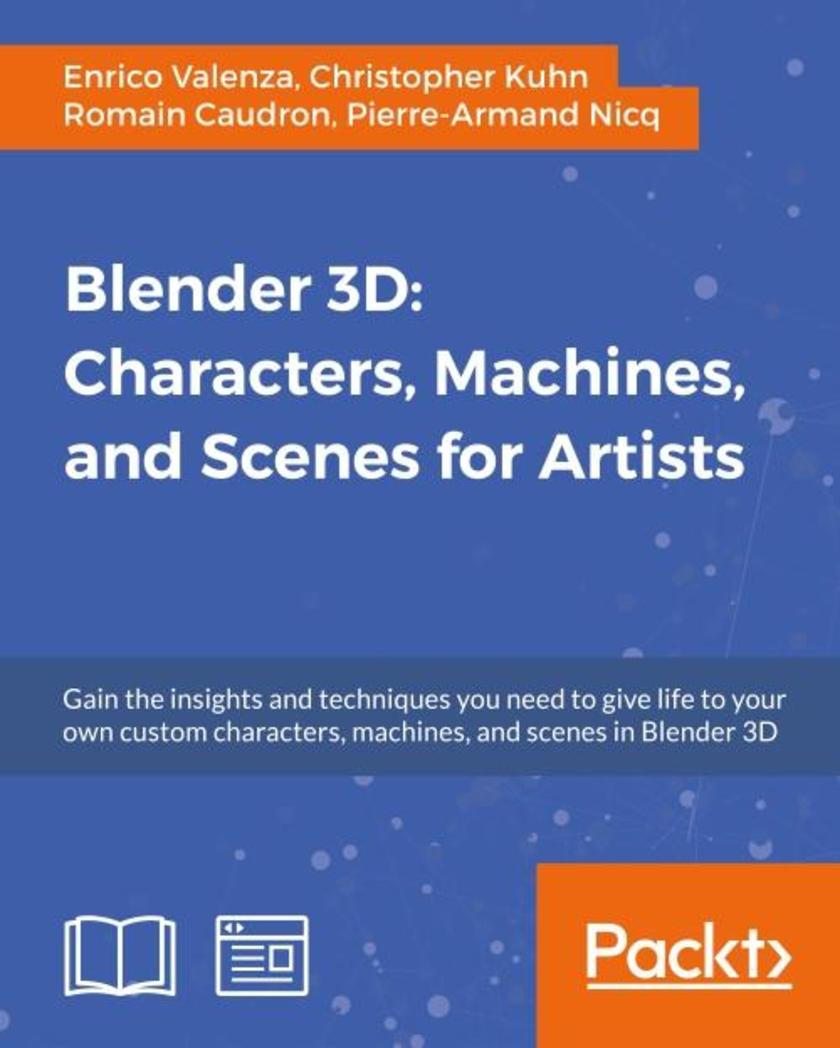
Blender 3D: Characters, Machines, and Scenes for Artists
¥179.84
Gain the insights and techniques you need to give life to your own custom characters, machines, and scenes in Blender 3D About This Book Learn how to establish the basic shape of a character on the basis of templates, and take it to completion using the tools available in Blender Develop realistic and awesome machines for your 3D projects and animation films Discover advanced techniques by adding fur to a character, creating a grass field, and fine-tuning a shot with post-processing effects to enhance your creations Who This Book Is For This learning path is for those who know the basics of Blender and have hands-on experience with the software. We will directly dive into creating characters first. If you wish to use Blender to create games, animated films, and architecture simulations, this learning path will benefit you. What You Will Learn Use your sculpting skills to carve the character features from the mesh Find the best possible flow for your edge-loops to enhance the character features and to get the best possible range of deformation Mix both the Blender Internal and Cycles rendering engines in order to render materials as quickly as possible Know when and where to use various types of geometry—something that saves time in one instance will pose significant problems in another Create a 3D robot toy model from start to finish using the basic modeling tools of Blender Make a full alien character using the skin mesh modifier and the sculpting tools with an artistic approach Use re-topology techniques to create a clean 3D version of the previously sculpted alien Model a full haunted house and its environment using more advanced modeling tools and techniques such as the Array Modifier, Instance duplication, and Curves In Detail Blender 3D is one of the top 3D animation software available. As the Blender software grows more powerful and popular, there is a demand to take your modeling skills to the next level. This learning path is divided into three modules that will take you on this incredible journey of creating games. The first module will take you on a journey to understand the workflow normally used to create characters, from the modeling to the rendering stages, using the tools of the last official release of Blender exclusively. You will be making production-quality 3D models and characters quickly and efficiently, which will be ready to be added to your very own animated feature or game. The second module will help you develop a comprehensive skill set that covers the key aspects of mechanical modeling. You will create many types of projects, including a pistol, spacecraft, robot, and a racer. By the end of this module, you will have mastered a workflow that you will be able to apply to your own creations. The final module will help you to create many types of projects using a step-by-step approach. Each project in this module will give you more practice and increase your knowledge of the Blender tools and game engine. This learning path combines some of the best that Packt has to offer in one complete, curated package. It includes content from the following Packt products: Blender 3D Cookbook, Second Edition by Enrico Valenza Blender 3D Incredible Machines, Second Edition by Christopher Kuhn Blender 3D By Example by Romain Caudron and Pierre-Armand Nicq Style and approach This easy-to-follow course will teach you how to create complex 3D characters, create incredible machines, and put them together to create a 3D scene. Each topic is explained sequentially in the process of creating various models, and includes detailed explanations of the basic and advanced features.
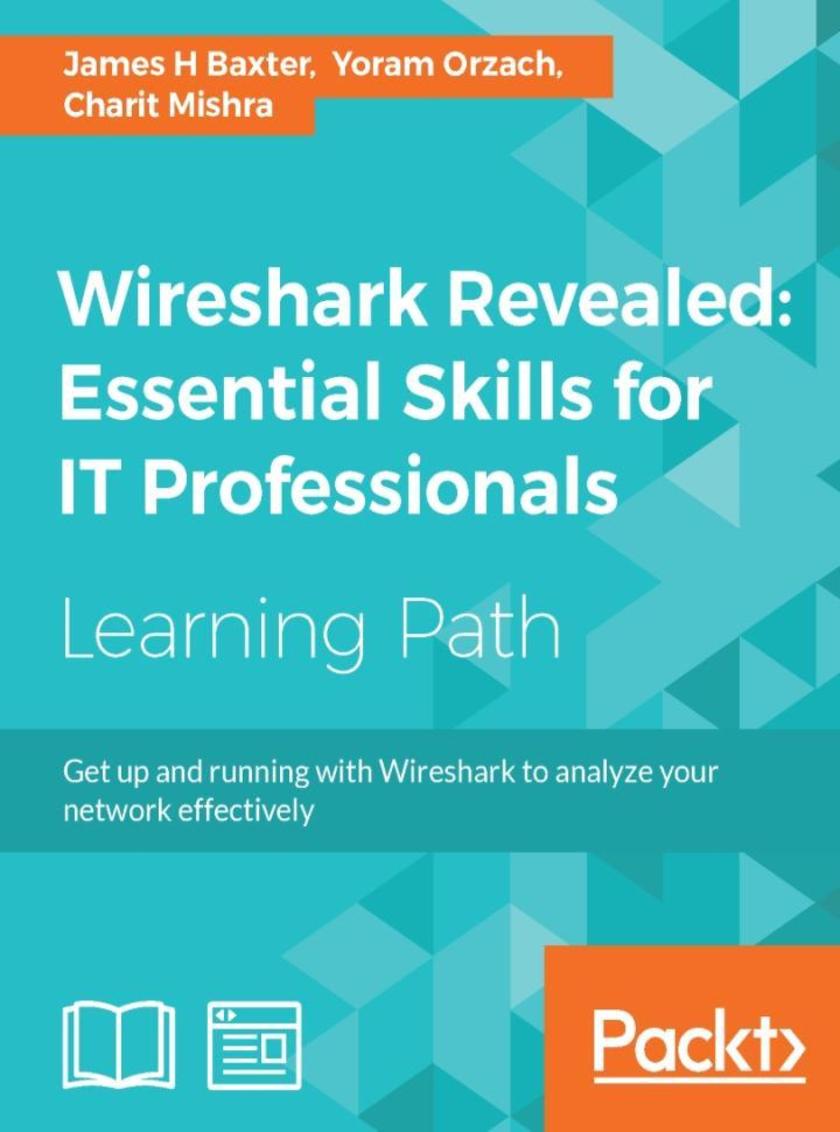
Wireshark Revealed: Essential Skills for IT Professionals
¥179.84
Master Wireshark and discover how to analyze network packets and protocols effectively, along with engaging recipes to troubleshoot network problems About This Book ? Gain valuable insights into the network and application protocols, and the key fields in each protocol ? Use Wireshark’s powerful statistical tools to analyze your network and leverage its expert system to pinpoint network problems ? Master Wireshark and train it as your network sniffer Who This Book Is For This book is aimed at IT professionals who want to develop or enhance their packet analysis skills. A basic familiarity with common network and application services terms and technologies is assumed. What You Will Learn ? Discover how packet analysts view networks and the role of protocols at the packet level ? Capture and isolate all the right packets to perform a thorough analysis using Wireshark’s extensive capture and display filtering capabilities ? Decrypt encrypted wireless traffic ? Use Wireshark as a diagnostic tool and also for network security analysis to keep track of malware ? Find and resolve problems due to bandwidth, throughput, and packet loss ? Identify and locate faults in communication applications including HTTP, FTP, mail, and various other applications – Microsoft OS problems, databases, voice, and video over IP ? Identify and locate faults in detecting security failures and security breaches in the network In Detail This Learning Path starts off installing Wireshark, before gradually taking you through your first packet capture, identifying and filtering out just the packets of interest, and saving them to a new file for later analysis. You will then discover different ways to create and use capture and display filters. By halfway through the book, you'll be mastering Wireshark features, analyzing different layers of the network protocol, and looking for any anomalies.We then start Ethernet and LAN switching, through IP, and then move on to TCP/UDP with a focus on TCP performance problems. It also focuses on WLAN security. Then, we go through application behavior issues including HTTP, mail, DNS, and other common protocols. This book finishes with a look at network forensics and how to locate security problems that might harm the network.This course provides you with highly practical content explaining Metasploit from the following books: 1) Wireshark Essentials 2) Network Analysis Using Wireshark Cookbook 3) Mastering Wireshark Style and approach This step-by-step guide follows a practical approach, starting from the basic to the advanced aspects. Through a series of real-world examples, this learning path will focus on making it easy for you to become an expert at using Wireshark.
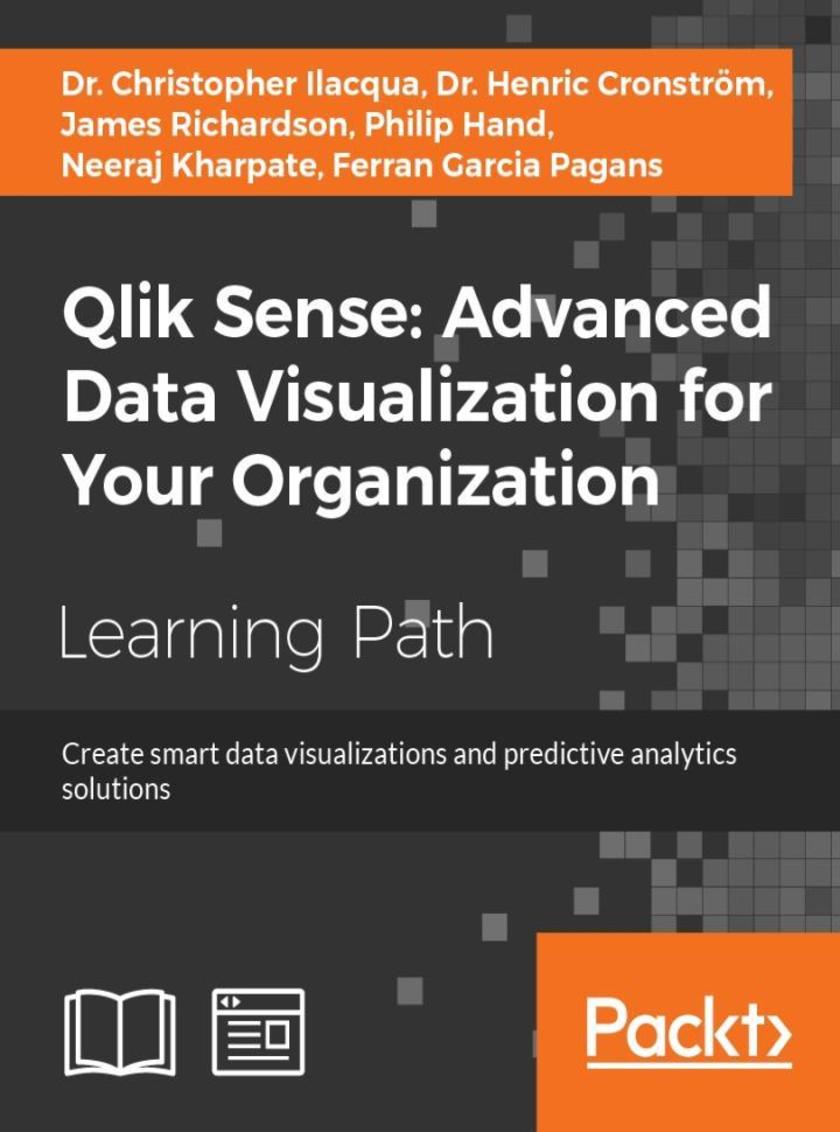
Qlik Sense: Advanced Data Visualization for Your Organization
¥179.84
Perform Interactive Data Analysis with Smarter Visualizations and Support your Enterprise-wide Analytical Needs About This Book ? Get a practical demonstration of discovering data for sales, human resources, and more using Qlik Sense ? Create dynamic dashboards for business intelligence and predictive analytics ? Create and collaborate comprehensive analytical solutions using Rattle and Qlik Sense Who This Book Is For This course is for anyone who wishes to understand and utilize the various new approaches to business intelligence actively in their business practice. Knowing the basics of business intelligence concepts would be helpful when picking up this course, but is not mandatory. What You Will Learn ? Build simple visualization models with Rattle and Qlik Sense Desktop ? Get to grips with the life cycle and new visualization functions of a Qlik Sense application ? Discover simple ways to examine data and get it ready for analysis ? Visualize your data with Qlik Sense's engaging and informative graphs ? Build efficient and responsive Associative Models ? Optimize Qlik Sense for sales, human resources, and demographic data discovery ? Explore various tips and tricks of navigation for the Qlik Sense? front end ? Develop creative extensions for your Qlik Sense? dashboard In Detail Qlik Sense is powerful and creative visual analytics software that allows users to discover data, explore it, and dig out meaningful insights in order to make a profit and make decisions for your business. This course begins by introducing you to the features and functions of the most modern edition of Qlik Sense so you get to grips with the application. The course will teach you how to administer the data architecture in Qlik Sense, enabling you to customize your own Qlik Sense application for your business intelligence needs. It also contains numerous recipes to help you overcome challenging situations while creating fully featured desktop applications in Qlik Sense. It explains how to combine Rattle and Qlik Sense Desktop to apply predictive analytics to your data to develop real-world interactive data applications. The course includes premium content from three of our most popular books: ? Learning Qlik Sense: The Official Guide Second Edition ? Qlik Sense Cookbook ? Predictive Analytics using Rattle and Qlik Sense On completion of this course, you will be self-sufficient in improving your data analysis and will know how to apply predictive analytics to your datasets. Through this course, you will be able to create predictive models and data applications, allowing you to explore your data insights much deeper. Style and approach The course will follow a practical approach with rich set of examples through which it will demonstrate its concepts, features and its implementation. The course will also feature numerous solutions which will cover entire spectrum of BI use cases.

Linux: Powerful Server Administration
¥179.84
Get hands-on recipes to make the most of Ubuntu Server, CentOS 7 Linux Server and RHEL 7 Server About This Book * Get Linux servers up and running in seconds, * In-depth guide to explore new features and solutions in server administration * Maintain performance and security of your server solution by deploying expert configuration advice Who This Book Is For This Learning Path is intended for system administrators with a basic understanding of Linux operating systems and written with the novice-to-intermediate Linux user in mind. To get the most of this Learning Path, you should have a working knowledge of basic system administration and management tools. What You Will Learn * Set up high performance, scalable, and fault-tolerant back ends with web and database servers * Facilitate team communication with a real-time chat service and collaboration tools * Monitor, manage and develop your server's file system to maintain a stable performance * Gain best practice methods on sharing files and resources through a network * Install and configure common standard services such as web, mail, FTP, database and domain name server technologies * Create kickstart *s to automatically deploy RHEL 7 systems * Use Orchestration and configuration management tools to manage your environment In Detail Linux servers are frequently selected over other server operating systems for their stability, security and flexibility advantages.This Learning Path will teach you how to get up and running with three of the most popular Linux server distros: Ubuntu Server, CentOS 7 Server, and RHEL 7 Server. We will begin with the Ubuntu Server and show you how to make the most of Ubuntu's advanced functionalities. Moving on, we will provide you with all the knowledge that will give you access to the inner workings of the latest CentOS version 7. Finally, touching RHEL 7, we will provide you with solutions to common RHEL 7 Server challenges.This Learning Path combines some of the best that Packt has to offer in one complete, curated package. It includes content from the following Packt products: 1)Ubuntu Server Cookbook 2)CentOS 7 Linux Server Cookbook, Second Edition 3)Red Hat Enterprise Linux Server Cookbook Style and approach This easy-to-follow practical guide contains hands on examples and solutions to real word administration problems and problems faced when building your RHEL 7 system from scratch using orchestration tools.
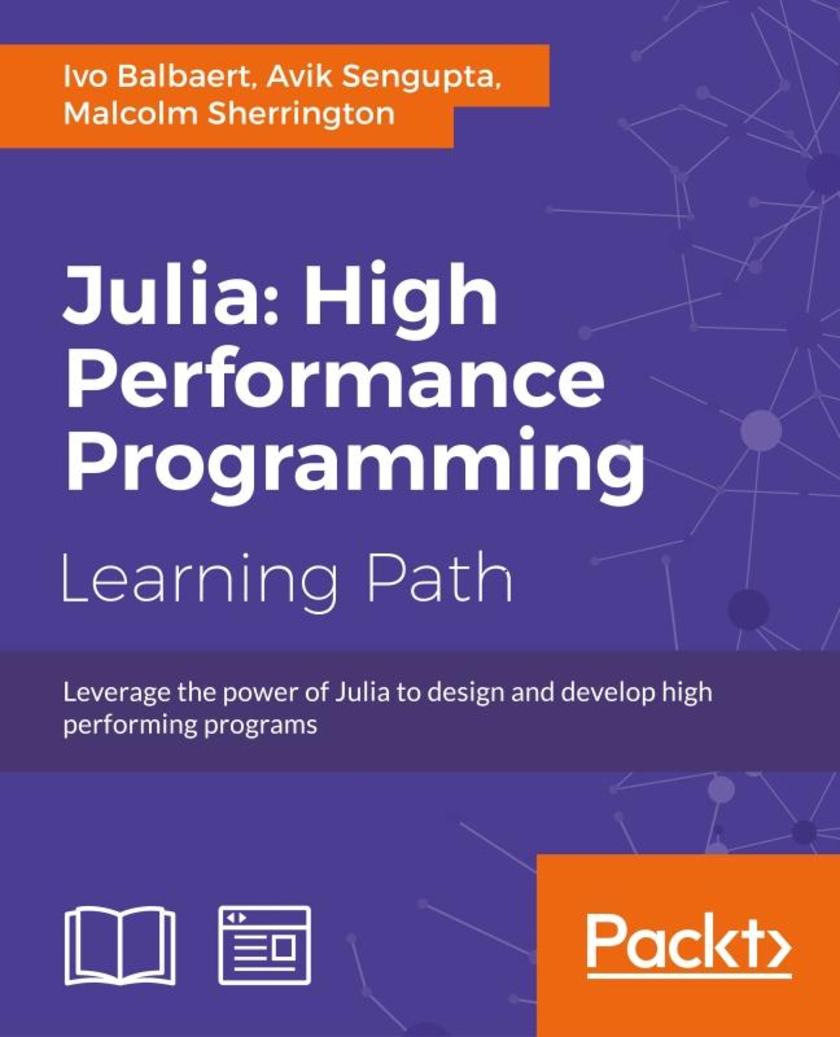
Julia: High Performance Programming
¥179.84
Leverage the power of Julia to design and develop high performing programs About This Book Get to know the best techniques to create blazingly fast programs with Julia Stand out from the crowd by developing code that runs faster than your peers' code Complete an extensive data science project through the entire cycle from ETL to analytics and data visualization Who This Book Is For This learning path is for data scientists and for all those who work in technical and scientific computation projects. It will be great for Julia developers who are interested in high-performance technical computing. This learning path assumes that you already have some basic working knowledge of Julia's syntax and high-level dynamic languages such as MATLAB, R, Python, or Ruby. What You Will Learn Set up your Julia environment to achieve the highest productivity Solve your tasks in a high-level dynamic language and use types for your data only when needed Apply Julia to tackle problems concurrently and in a distributed environment Get a sense of the possibilities and limitations of Julia's performance Use Julia arrays to write high performance code Build a data science project through the entire cycle of ETL, analytics, and data visualization Display graphics and visualizations to carry out modeling and simulation in Julia Develop your own packages and contribute to the Julia Community In Detail In this learning path, you will learn to use an interesting and dynamic programming language—Julia! You will get a chance to tackle your numerical and data problems with Julia. You’ll begin the journey by setting up a running Julia platform before exploring its various built-in types. We’ll then move on to the various functions and constructs in Julia. We’ll walk through the two important collection types—arrays and matrices in Julia. You will dive into how Julia uses type information to achieve its performance goals, and how to use multiple dispatch to help the compiler emit high performance machine code. You will see how Julia’s design makes code fast, and you’ll see its distributed computing capabilities. By the end of this learning path, you will see how data works using simple statistics and analytics, and you’ll discover its high and dynamic performance—its real strength, which makes it particularly useful in highly intensive computing tasks. This learning path combines some of the best that Packt has to offer in one complete, curated package. It includes content from the following Packt products: Getting Started with Julia by Ivo Balvaert Julia High Performance by Avik Sengupta Mastering Julia by Malcolm Sherrington Style and approach This hands-on manual will give you great explanations of the important concepts related to Julia programming.
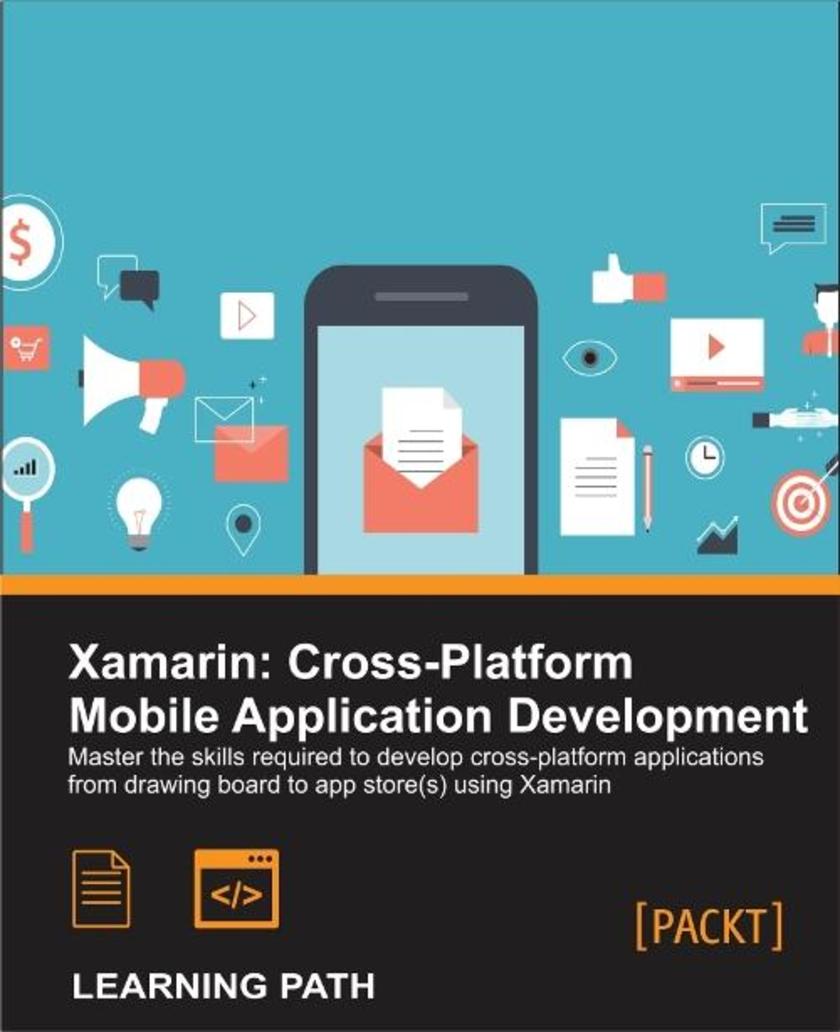
Xamarin: Cross-Platform Mobile Application Development
¥179.84
Master the skills required to develop cross-platform applications from drawing board to app store(s) using Xamarin About This Book Learn to deliver high-performance native apps that leverage platform specific acceleration, complied for native performance Learn development techniques that will allow you to use and create custom layouts for cross-platform UI Gain the knowledge needed to become more efficient in testing, deploying, and monitoring your applications Implement application life cycle management concepts to manage cross-platform projects Who This Book Is For Mobile application developers wanting to develop skills required to steer cross-platform applications using Xamarin. What You Will Learn Share C# code across platforms and call native Objective-C or Java libraries from C# Submit your app to the Apple App Store and Google Play Use the out-of-the-box services to support third-party libraries Find out how to get feedback while your application is used by your users Create shared data access using a local SQLite database and a REST service Test and monitor your applications Gain memory management skills to avoid memory leaks and premature code cycles while decreasing the memory print of your applications Integrate network resources with cross-platform applications Design and implement eye-catching and reusable UI components without compromising on nativity in mobile applications In Detail Developing a mobile application for just one platform is becoming a thing of the past. Companies expect their apps to be supported on iOS, Android and Windows Phone, while leveraging the best native features on all three platforms. Xamarin's tools help ease this problem by giving developers a single toolset to target all three platforms. The main goal of this course is to equip you with knowledge to successfully analyze, develop, and manage Xamarin cross-platform projects using the most efficient, robust, and scalable implementation patterns. Module 1 is a step-by-step guide to building real-world applications for iOS and Android. The module walks you through building a chat application, complete with a backend web service and native features such as GPS location, camera, and push notifications. Additionally, you'll learn how to use external libraries with Xamarin and Xamarin.Forms. Module 2 provide you recipes on how to create an architecture that will be maintainable, extendable, use Xamarin.Forms plugins to boost productivity. We start with a simple creation of a Xamarin.Forms solution, customize the style and behavior of views for each platform. Further on, we demonstrate the power of architecting a cross-platform solution. Next, you will utilize and access hardware features that vary from platform to platform with cross-platform techniques. You will master the steps of getting the app ready and publishing it in the app store. The last module starts with general topics such as memory management, asynchronous programming, local storage, networking, and platform-specific features. You will learn about key tools to leverage the pattern and advanced implementation strategies. Finally, we show you the toolset for application lifecycle management to help you prepare the development pipeline to manage and see cross-platform projects through to public or private release. After the completion of this course, you will learn a path that will get you up and running with developing cross-platform mobile applications and help you become the go-to person when it comes to Xamarin. Style and approach This course will serve as comprehensive guide for developing cross-platform applications with Xamarin with a unique approach that will engage you like never before as you create real-world cross-platform apps on your own.
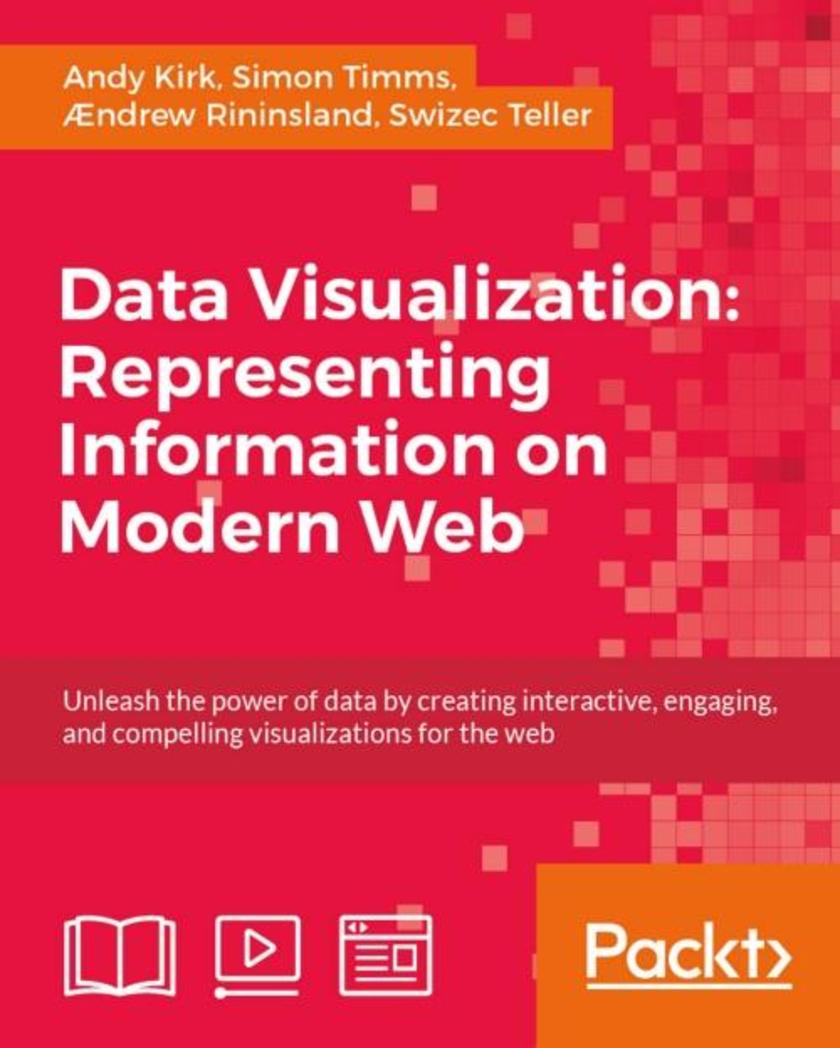
Data Visualization: Representing Information on Modern Web
¥179.84
Unleash the power of data by creating interactive, engaging, and compelling visualizations for the web About This Book Get a portable, versatile, and flexible data visualization design approach that will help you navigate the complex path towards success Get thorough explanation of the many visual variables and visualization taxonomy to provide you with a menu of creative options A comprehensive and contemporary introduction to data-driven visualization design and the most effective approaches to designing impact-maximizing and cognition-amplifying visualizations Who This Book Is For This course is for developers who are excited about data and who want to share that excitement with others and it will be handy for the web developers or data scientists who want to create interactive visualizations for the web. Prior knowledge of developing web applications is required. You should have a working knowledge of both JavaScript and HTML. What You Will Learn Harness the power of D3 by building interactive and real-time data-driven web visualizations Find out how to use JavaScript to create compelling visualizations of social data Identify the purpose of your visualization and your project's parameters to determine overriding design considerations across your project's execution Apply critical thinking to visualization design and get intimate with your dataset to identify its potential visual characteristics Explore the various features of HTML5 to design creative visualizations Discover what data is available on Stack Overflow, Facebook, Twitter, and Google+ Gain a solid understanding of the common D3 development idioms Find out how to write basic D3 code for server using Node.js In Detail Do you want to create more attractive chartsOr do you have huge data sets and need to unearth the key insights in a visual mannerData visualization is the representation and presentation of data, using proven design techniques to bring alive the patterns, stories, and key insights that are locked away. This learning path is divided into three modules. The first module will equip you with the key techniques required to overcome contemporary data visualization challenges. In the second module, Social Data Visualization with HTML5 and JavaScript, it teaches you how to leverage HTML5 techniques through JavaScript to build visualizations. In third module, Learning d3.js Data Visualization, will lead you to D3, which has emerged as one of the leading platforms to develop beautiful, interactive visualizations over the web. By the end of this course, you will have unlocked the mystery behind successful data visualizations. This Learning Path combines some of the best that Packt has to offer in one complete, curated package. It includes content from the following Packt products: ● Data Visualization: a successful design process by Andy Kirk ● Social Data Visualization with HTML5 and JavaScript by Simon Timms ● Learning d3.js Data Visualization, Second Edition by ?ndrew Rininsland and Swizec Teller Style and approach This course includes all the resources that will help you jump into creating interactive and engaging visualizations for the web. Through this comprehensive course, you’ll learn how to create engaging visualizations for the web to represent your data from start to finish!
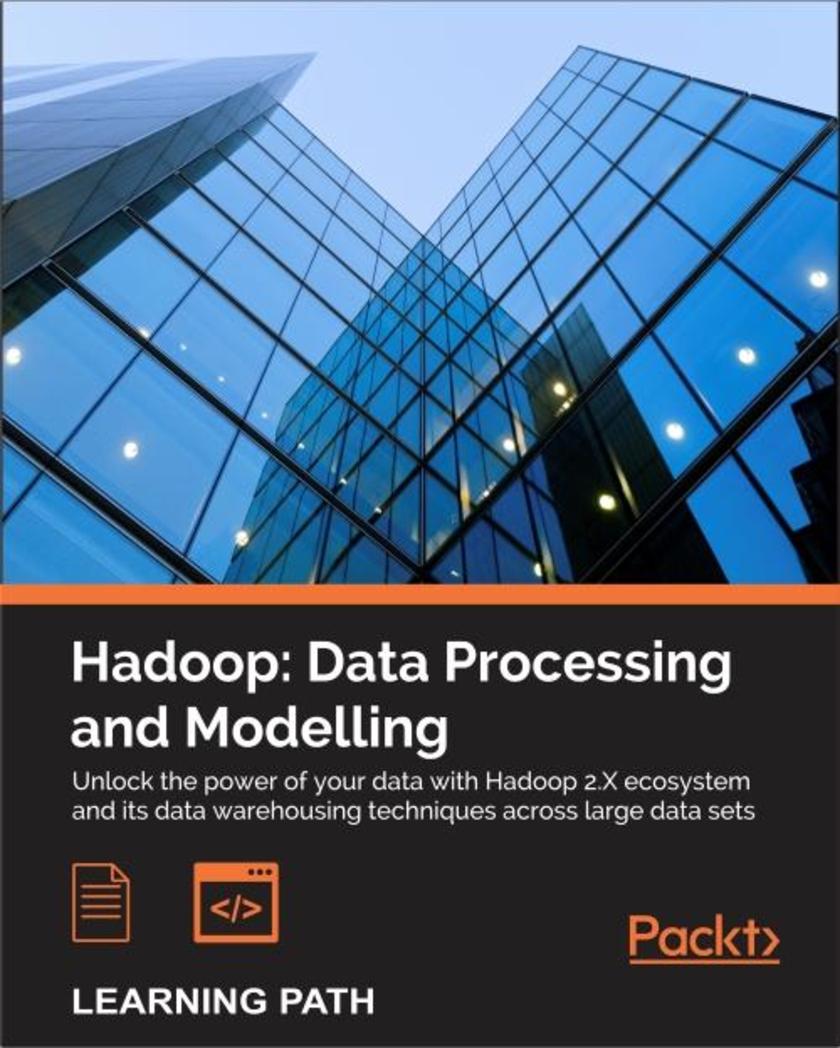
Hadoop: Data Processing and Modelling
¥179.84
Unlock the power of your data with Hadoop 2.X ecosystem and its data warehousing techniques across large data sets About This Book Conquer the mountain of data using Hadoop 2.X tools The authors succeed in creating a context for Hadoop and its ecosystem Hands-on examples and recipes giving the bigger picture and helping you to master Hadoop 2.X data processing platforms Overcome the challenging data processing problems using this exhaustive course with Hadoop 2.X Who This Book Is For This course is for Java developers, who know *ing, wanting a career shift to Hadoop - Big Data segment of the IT industry. So if you are a novice in Hadoop or an expert, this book will make you reach the most advanced level in Hadoop 2.X. What You Will Learn Best practices for setup and configuration of Hadoop clusters, tailoring the system to the problem at hand Integration with relational databases, using Hive for SQL queries and Sqoop for data transfer Installing and maintaining Hadoop 2.X cluster and its ecosystem Advanced Data Analysis using the Hive, Pig, and Map Reduce programs Machine learning principles with libraries such as Mahout and Batch and Stream data processing using Apache Spark Understand the changes involved in the process in the move from Hadoop 1.0 to Hadoop 2.0 Dive into YARN and Storm and use YARN to integrate Storm with Hadoop Deploy Hadoop on Amazon Elastic MapReduce and Discover HDFS replacements and learn about HDFS Federation In Detail As Marc Andreessen has said “Data is eating the world,” which can be witnessed today being the age of Big Data, businesses are producing data in huge volumes every day and this rise in tide of data need to be organized and analyzed in a more secured way. With proper and effective use of Hadoop, you can build new-improved models, and based on that you will be able to make the right decisions. The first module, Hadoop beginners Guide will walk you through on understanding Hadoop with very detailed instructions and how to go about using it. Commands are explained using sections called “What just happened” for more clarity and understanding. The second module, Hadoop Real World Solutions Cookbook, 2nd edition, is an essential tutorial to effectively implement a big data warehouse in your business, where you get detailed practices on the latest technologies such as YARN and Spark. Big data has become a key basis of competition and the new waves of productivity growth. Hence, once you get familiar with the basics and implement the end-to-end big data use cases, you will start exploring the third module, Mastering Hadoop. So, now the question is if you need to broaden your Hadoop skill set to the next level after you nail the basics and the advance concepts, then this course is indispensable. When you finish this course, you will be able to tackle the real-world scenarios and become a big data expert using the tools and the knowledge based on the various step-by-step tutorials and recipes. Style and approach This course has covered everything right from the basic concepts of Hadoop till you master the advance mechanisms to become a big data expert. The goal here is to help you learn the basic essentials using the step-by-step tutorials and from there moving toward the recipes with various real-world solutions for you. It covers all the important aspects of Hadoop from system designing and configuring Hadoop, machine learning principles with various libraries with chapters illustrated with code fragments and schematic diagrams. This is a compendious course to explore Hadoop from the basics to the most advanced techniques available in Hadoop 2.X.
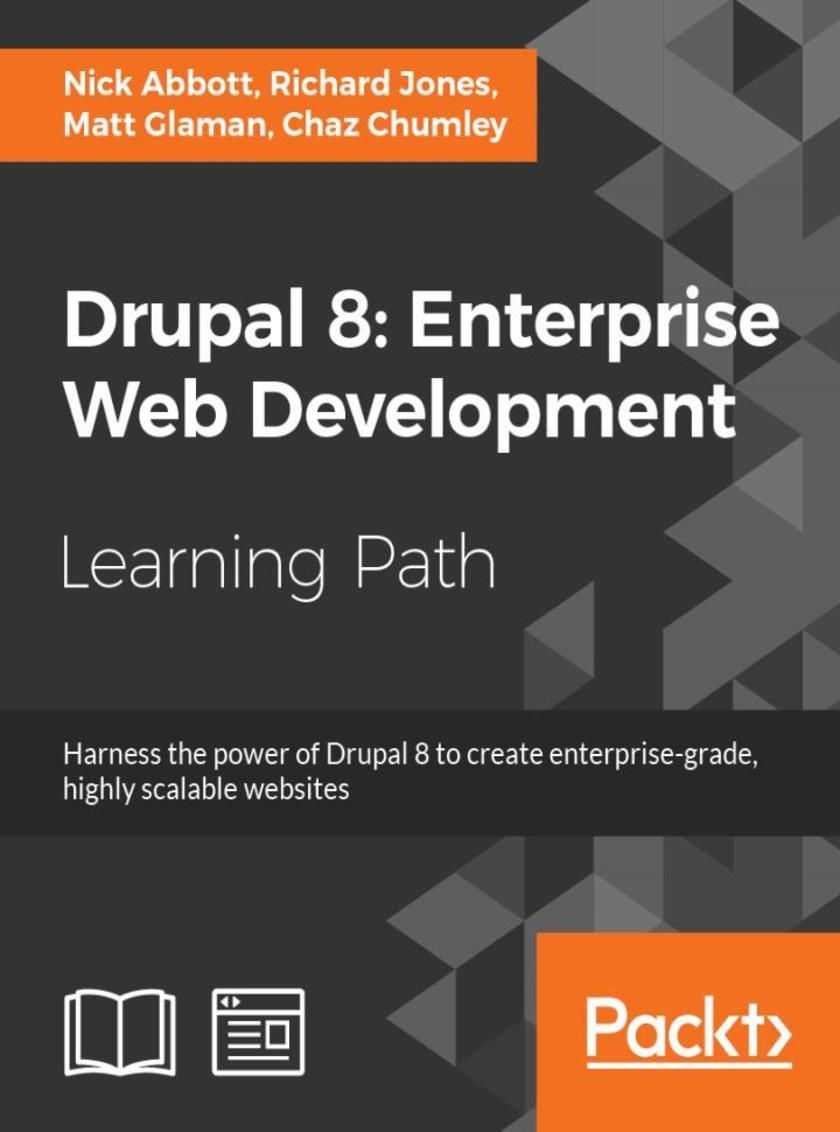
Drupal 8: Enterprise Web Development
¥179.84
Harness the power of Drupal 8 to create enterprise-grade, highly scalable websites About This Book Build complete, complex websites with no prior knowledge of web development entirely using the intuitive Drupal user interface Ensure your sites are modern, responsive and mobile-friendly through utilizing the full features available in Drupal 8 Quickly master theme administration, custom block layouts, views, and the Twig template structure Who This Book Is For This course is suitable for web developers, designers, as well as web administrators who are keen on building modern, scalable websites using Drupal 8 and its wide range of new features. What You Will Learn Set up a local “stack” development environment and install your first Drupal 8 site Find out what is available in the Drupal 8 core Integrate third-party front-end and back-end libraries with Drupal Understand the plugin system that powers many of Drupal 8's new APIs to extend its functionality Build custom block layouts with reusable and fieldable blocks Work with the new Twig PHP templating engine Develop a theme from scratch following a step-by-step project outline In Detail This Drupal 8 course takes you through the journey of building, extending, and customizing websites to build highly scalable and enterprise-ready websites. The first part—Learning Drupal 8—takes you step by step through building a Drupal 8 website. You will start with the basics, such as setting up a local “stack” development environment and installing your first Drupal 8 site, then we move on to image and media handling and extending Drupal modules. This section will help you get to grips with the modular nature of Drupal, and you’ll learn how to extend it by adding new functionalities to create your new modules. After learning to develop and manage a modern and responsive website using Drupal 8, you’ll start exploring different techniques to take advantage of the new Drupal 8 features. The next module—Drupal 8 Development Cookbook—is your go-to guide to experimenting with all of Drupal 8’s features through helpful recipes. You will explore techniques to customize and configure the Drupal environment, create blocks and custom modules, as well as make your web apps responsive by harnessing the mobile-first feature of Drupal 8. This module will also show you how to incorporate multilingual facilities in your sites, use web services and third-party plugins with your applications from inside Drupal 8, and test and deploy your apps. In the third part—Drupal 8 Theming with Twig—you will master Drupal 8’s new Twig templating engine to customize the look and feel of your website. This section will walk you through a real-world project to create a Twig theme from concept to completion while adopting best practices to implement CSS frameworks and JavaScript libraries. You will see just how quick and easy it is to create beautiful, responsive Drupal 8 websites while avoiding the common mistakes that many front-end developers make. By the end, you will have learned how to develop, manage, extend, and customize an enterprise-level website. This Learning Path combines some of the best that Packt has to offer in one complete, curated package. It includes content from the following Packt products: Learning Drupal 8 by Nick Abbott and Richard Jones Drupal 8 Development Cookbook by Matt Glaman Drupal 8 Theming with Twig by Chaz Chumley Style and approach This course offers a thorough coverage of developing, managing, extending, and designing highly scalable websites using the Drupal 8 platform. Filled with practical examples and recipes, this course is a great combination of example-driven learning complemented by interesting techniques to take advantage of the Drupal platform.

Embedded Linux for Developers
¥179.84
Leverage the power of Linux to develop captivating and powerful embedded Linux projects About This Book Explore the best practices for all embedded product development stages Learn about the compelling features offered by the Yocto Project, such as customization, virtualization, and many more Minimize project costs by using open source tools and programs Who This Book Is For If you are a developer who wants to build embedded systems using Linux, this book is for you. It is the ideal guide for you if you want to become proficient and broaden your knowledge. A basic understanding of C programming and experience with systems programming is needed. Experienced embedded Yocto developers will find new insight into working methodologies and ARM specific development competence. What You Will Learn Use the Yocto Project in the embedded Linux development process Get familiar with and customize the bootloader for a board Discover more about real-time layer, security, virtualization, CGL, and LSB See development workflows for the U-Boot and the Linux kernel, including debugging and optimization Understand the open source licensing requirements and how to comply with them when cohabiting with proprietary programs Optimize your production systems by reducing the size of both the Linux kernel and root filesystems Understand device trees and make changes to accommodate new hardware on your device Design and write multi-threaded applications using POSIX threads Measure real-time latencies and tune the Linux kernel to minimize them In Detail Embedded Linux is a complete Linux distribution employed to operate embedded devices such as smartphones, tablets, PDAs, set-top boxes, and many more. An example of an embedded Linux distribution is Android, developed by Google. This learning path starts with the module Learning Embedded Linux Using the Yocto Project. It introduces embedded Linux software and hardware architecture and presents information about the bootloader. You will go through Linux kernel features and source code and get an overview of the Yocto Project components available. The next module Embedded Linux Projects Using Yocto Project Cookbook takes you through the installation of a professional embedded Yocto setup, then advises you on best practices. Finally, it explains how to quickly get hands-on with the Freescale ARM ecosystem and community layer using the affordable and open source Wandboard embedded board. Moving ahead, the final module Mastering Embedded Linux Programming takes you through the product cycle and gives you an in-depth de*ion of the components and options that are available at each stage. You will see how functions are split between processes and the usage of POSIX threads. By the end of this learning path, your capabilities will be enhanced to create robust and versatile embedded projects. This Learning Path combines some of the best that Packt has to offer in one complete, curated package. It includes content from the following Packt products: Learning Embedded Linux Using the Yocto Project by Alexandru Vaduva Embedded Linux Projects Using Yocto Project Cookbook by Alex González Mastering Embedded Linux Programming by Chris Simmonds Style and approach This comprehensive, step-by-step, pragmatic guide enables you to build custom versions of Linux for new embedded systems with examples that are immediately applicable to your embedded developments. Practical examples provide an easy-to-follow way to learn Yocto project development using the best practices and working methodologies. Coupled with hints and best practices, this will help you understand embedded Linux better.
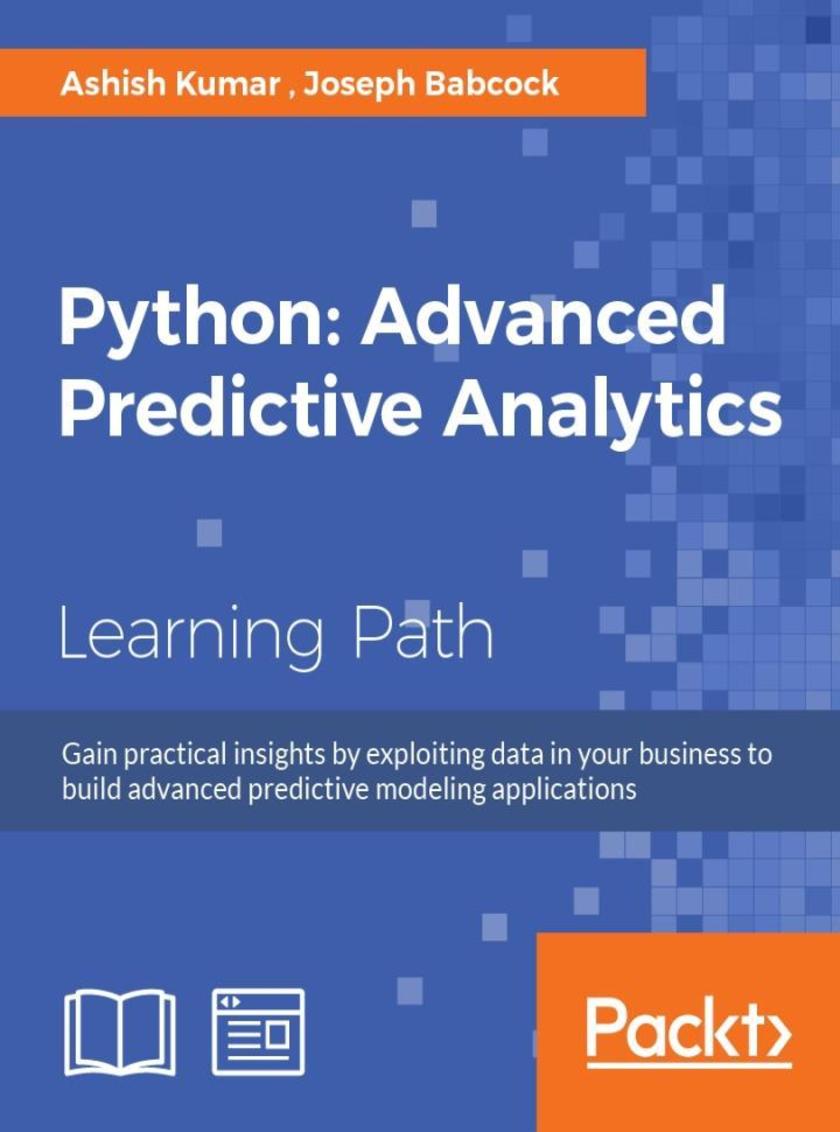
Python: Advanced Predictive Analytics
¥179.84
Gain practical insights by exploiting data in your business to build advanced predictive modeling applications About This Book ? A step-by-step guide to predictive modeling including lots of tips, tricks, and best practices ? Learn how to use popular predictive modeling algorithms such as Linear Regression, Decision Trees, Logistic Regression, and Clustering ? Master open source Python tools to build sophisticated predictive models Who This Book Is For This book is designed for business analysts, BI analysts, data scientists, or junior level data analysts who are ready to move on from a conceptual understanding of advanced analytics and become an expert in designing and building advanced analytics solutions using Python. If you are familiar with coding in Python (or some other programming/statistical/*ing language) but have never used or read about predictive analytics algorithms, this book will also help you. What You Will Learn ? Understand the statistical and mathematical concepts behind predictive analytics algorithms and implement them using Python libraries ? Get to know various methods for importing, cleaning, sub-setting, merging, joining, concatenating, exploring, grouping, and plotting data with pandas and NumPy ? Master the use of Python notebooks for exploratory data analysis and rapid prototyping ? Get to grips with applying regression, classification, clustering, and deep learning algorithms ? Discover advanced methods to analyze structured and unstructured data ? Visualize the performance of models and the insights they produce ? Ensure the robustness of your analytic applications by mastering the best practices of predictive analysis In Detail Social Media and the Internet of Things have resulted in an avalanche of data. Data is powerful but not in its raw form; it needs to be processed and modeled, and Python is one of the most robust tools out there to do so. It has an array of packages for predictive modeling and a suite of IDEs to choose from. Using the Python programming language, analysts can use these sophisticated methods to build scalable analytic applications. This book is your guide to getting started with predictive analytics using Python. You'll balance both statistical and mathematical concepts, and implement them in Python using libraries such as pandas, scikit-learn, and NumPy. Through case studies and code examples using popular open-source Python libraries, this book illustrates the complete development process for analytic applications. Covering a wide range of algorithms for classification, regression, clustering, as well as cutting-edge techniques such as deep learning, this book illustrates explains how these methods work. You will learn to choose the right approach for your problem and how to develop engaging visualizations to bring to life the insights of predictive modeling. Finally, you will learn best practices in predictive modeling, as well as the different applications of predictive modeling in the modern world. The course provides you with highly practical content from the following Packt books: 1. Learning Predictive Analytics with Python 2. Mastering Predictive Analytics with Python Style and approach This course aims to create a smooth learning path that will teach you how to effectively perform predictive analytics using Python. Through this comprehensive course, you’ll learn the basics of predictive analytics and progress to predictive modeling in the modern world.

TypeScript: Modern JavaScript Development
¥179.84
Leverage the features of TypeScript to boost your development skills and create captivating applications About This Book Learn how to develop modular, scalable, maintainable, and adaptable web applications by taking advantage of TypeScript Explore techniques to use TypeScript alongside other leading tools such as Angular 2, React, and Node.js Focusing on design patterns in TypeScript, this step-by-step guide demonstrates all the important design patterns in practice Who This Book Is For This Learning Path is for intermediate-level JavaScript developers who want to use TypeScript to build beautiful web applications and fun projects. No prior knowledge of TypeScript is required, but a basic understanding of jQuery is expected. This Learning Path is also for experienced TypeScript developers who want to take their skills to the next level, and also for web developers who wish to make the most of TypeScript. What You Will Learn Understand the key TypeScript language features and runtime Install and configure the necessary tools in order to start developing an application Create object-oriented code that adheres to the SOLID principles Develop robust applications with testing (Mocha, Chai, and SinonJS) Apply GoF patterns in an application with a testing approach Identify the challenges when developing an application Migrate JavaScript codebases to TypeScript to improve your workflow Utilize System.JS and Webpack to load *s and their dependencies Develop high performance server-side applications to run within Node.js In Detail TypeScript is an open source and cross-platform typed superset of JavaScript that compiles to plain JavaScript that runs in any browser or any host. TypeScript adds optional static types, classes, and modules to JavaScript, to enable great tooling and better structuring of large JavaScript applications. Through this three-module learning path, you’ll learn the ins-and-outs of TypeScript for building more robust software. The first module gets you started with TypeScript and helps you understand the basics of TypeScript and automation tools. Get a detailed de*ion of function, generics, callbacks, and promises, and discover the object-oriented features and memory management functionality of TypeScript. The next module starts by explaining the current challenges when designing and developing an application and how you can solve these challenges by applying the correct design pattern and best practices. You will be introduced to low-level programming concepts to help you write TypeScript code, as well as working with software architecture, best practices, and design aspects. The final module will help you build a complete single page app with Angular 2, create a neat mobile app using NativeScript, and even build a Pac Man game with TypeScript. As if the fun wasn't enough, you'll also find out how to migrate your legacy codebase from JavaScript to TypeScript. By the end of this Learning Path, you will be able to take your skills up a notch and develop full-fledged web applications using the latest features of the TypeScript. This Learning Path combines some of the best that Packt has to offer in one complete, curated package. It includes content from the following Packt products: Learning TypeScript by Remo H. Jansen TypeScript Design Patterns by Vilic Vane TypeScript Blueprints by Ivo Gabe de Wolff Style and approach This is a step-by-step, practical guide covering the fundamentals of TypeScript with practical examples. The end-to-end projects included in this book will give you ready-to-implement solutions for your business scenario, showcasing the depth and robustness of TypeScript.
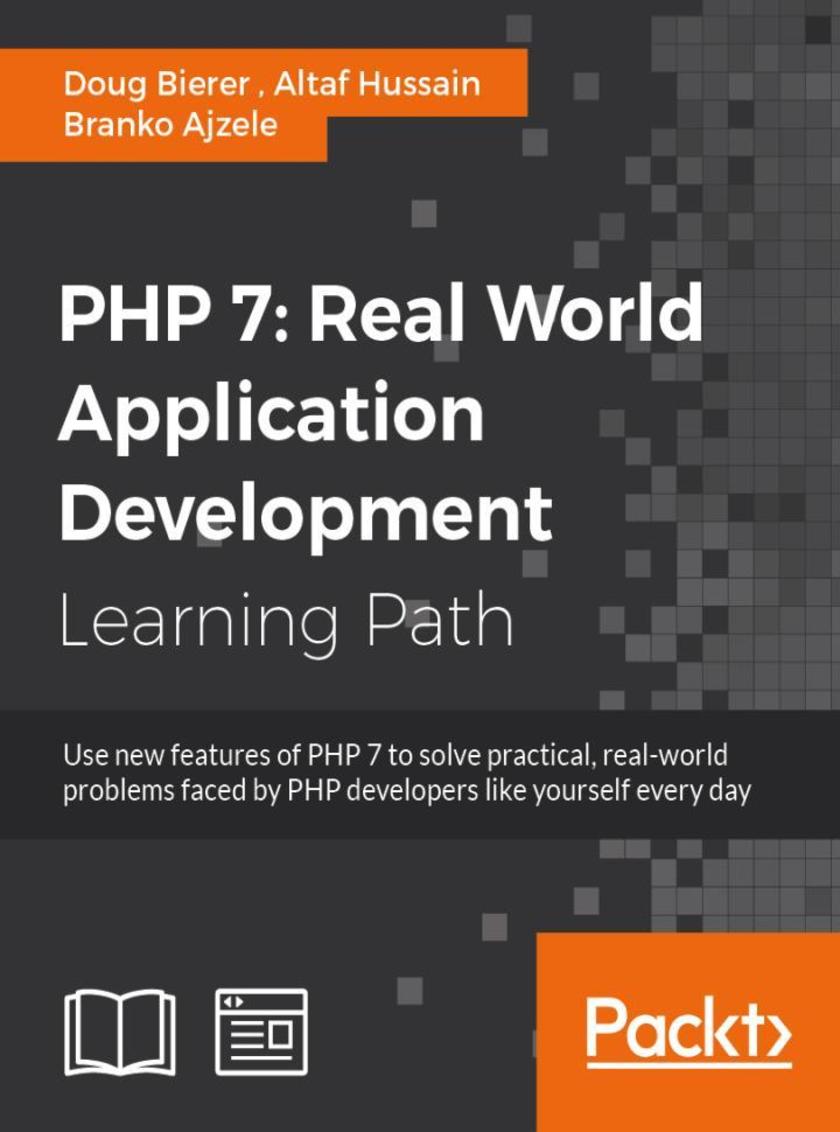
PHP 7: Real World Application Development
¥179.84
Use new features of PHP 7 to solve practical, real-world problems faced by PHP developers like yourself every day. About This Book .This course covers the new features of version 7.x, best practices for server-side programming, and MVC frameworks .Leverage the potential of PHP for server-side programming, memory management, and Object-Oriented Programming to improve your programming productivity .This course also illustrates the development of a complete modular application using PHP 7 in detail Who This Book Is For If you are an aspiring web developer, mobile developer, or back-end programmer, who has basic experience in PHP programming and wants to develop performance-critical applications, then this course is for you. It will take your PHP programming skills to next level. What You Will Learn .Solve practical real-world programming problems using PHP 7 .Discover where and when PHP 5 code needs to be re-written to avoid backwards-compatibility breaks .Use advanced PHP 7 features such as the Abstract Syntax Tree, Uniform Variable Syntax, Scalar Type Hints, Generator Delegation, Anonymous Classes, and the Context Sensitive Lexer .Set up a high performance development and production environment for PHP 7 .Discover new OOP features in PHP 7 to achieve high performance .Discover the new features of PHP 7 that are relevant to modular application development .Explore the ins and outs of the Symfony framework .Build a set of modules based on the Symfony framework that comprise a simple web shop app In Detail PHP is a great language for developing web applications. It is essentially a server-side *ing language. PHP 7 is the latest version, providing major backward-compatibility breaks and focusing on improved performance and speed. This course follows a learning path which is divided into three modules. Each module is a mini course in its own right, taking your basic PHP programing skills to the next level by showing you intermediate to advanced PHP techniques with a focus on PHP 7. This way, get you equipped with the tools and skills required to develop professional and efficient applications for your websites and enterprises. The first module of the book is a programming cookbook that consists over 80 recipes! Each recipe is designed to solve practical, real-world problems faced by PHP developers like yourself every day. This course also covers new ways of writing PHP code made possible only in version 7. The second module of the course is designed to improve the performance and productivity of your application. We’ll introduce you to the concepts of Object-Oriented Programming (OOP) in PHP 7, then shed some light on how to improve the performance of your PHP 7 applications and database. Throughout this module you will be introduced to benchmarking tools. With all important concepts of PHP covered up you will move on to third module. In this module you will gain a deep insight into the modular programming paradigm and how to achieve modularity in your PHP code. Modular design techniques help you build readable, manageable, reusable, and more efficient codes. PHP 7, which is a popular open source *ing language, is used to build modular functions for your software. This Learning Path combines some of the best that Packt has to offer in one complete, curated package. It includes content from the following Packt products: .PHP 7 Programming Cookbook, Doug Bierer .Learning PHP 7 High Performance, Altaf Hussain .Modular Programming with PHP 7, Branko Ajzele Style and approach This book takes a practical, step-by-step approach with real-world examples that serve as building blocks for your application development and guide you through improving the quality of your code.
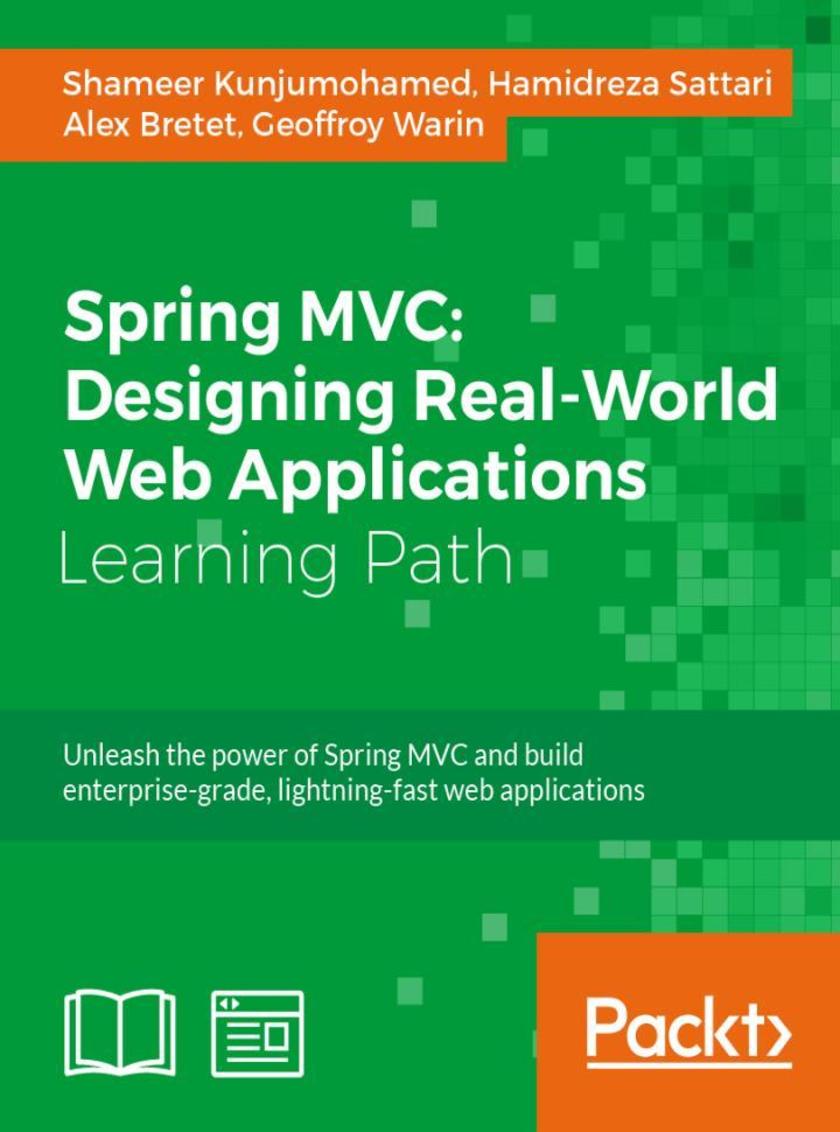
Spring MVC: Designing Real-World Web Applications
¥179.84
Unleash the power of Spring MVC and build enterprise-grade, lightning-fast web applications About This Book Configure Spring MVC to build logic-less controllers that transparently support the most advanced web techniques Secure your developments with easy-to-write, reliable unit and end-to-end tests Get this fast-paced, practical guide to produce REST resources and templates as required by the latest front-end best practices Who This Book Is For This Learning Path is for Java developers who want to exploit Spring MVC and its features to build web applications. It will help you step up in your career and stay up to date or learn more about Spring’s web scalability. What You Will Learn Set up and build standalone and web-based projects using Spring Framework with Maven or Gradle Develop RESTful API applications for XML and JSON data transfers Investigate Spring data access mechanisms with Spring Data Repositories Generate templates for a responsive and powerful front end with AngularJS and Bootstrap Authenticate over REST with a BASIC authentication scheme and OAuth2; handle roles and permissions Communicate through WebSocket and STOMP messages Design complex advanced-level forms and validate the model Create maintainable unit and acceptance tests to secure the apps Deploy the web application to the cloud in a snap In Detail Spring MVC helps you build flexible and loosely coupled web applications. The Spring MVC Framework is designed in such a way that every piece of logic and functionality is highly configurable. This Learning Path aims to make you an expert in designing web applications with Spring MVC 4. In our first module, we’ll begin with an introduction to the Spring framework. You'll then learn aspect-oriented programming. Packed with real-world examples, you’ll get an insight into how you can use Spring Expression Language in your applications to make them easier to manage and maintain. In the second module, you'll learn everything you need to build modern Spring-based enterprise web applications. From practical development techniques and useful tools from the wider Spring ecosystem, to the new JEE standards, the impact of JavaScript, and even the Internet of Things, you'll feel confident that you can deploy Spring for an impressive range of creative purposes. In the final module, you'll find out how to take advantage of Spring MVC's advanced features - essential if you are to properly master the framework. To do this you'll investigate the inner mechanics of Spring MVC, and how they tie into to the broader principles that inform many modern web architectures. With further guidance on how to test, secure, and optimize your application, as well as designing RESTful services, you'll very quickly be ready to use Spring in your next web project. This Learning Path combines some of the best that Packt has to offer in one complete, curated package. It includes content from the following Packt products: Spring Essentials by Shameer Kunjumohamed, Hamidreza Sattari Spring MVC Cookbook by Alex Bretet Mastering Spring MVC 4 by Geoffroy Warin Style and approach This is a hands-on, practical guide based on logical modules of the whole Spring framework family, employing a combination of theory and examples with pro-level practices, techniques, and solutions.
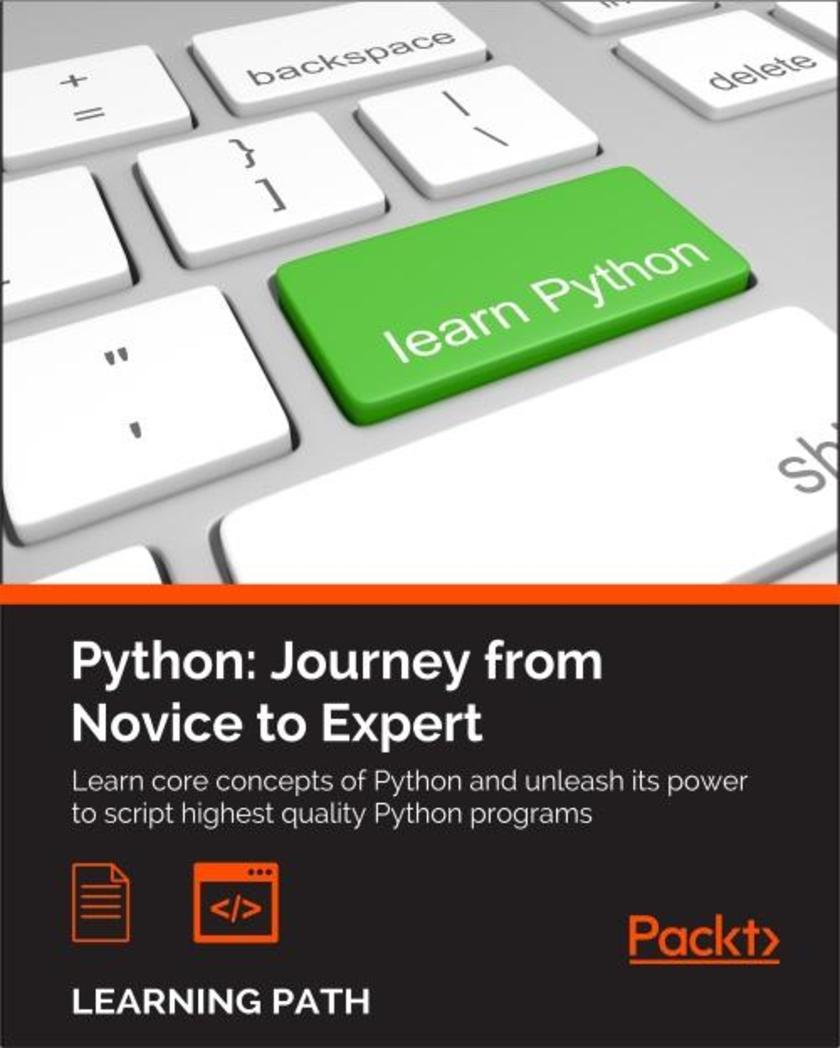
Python: Journey from Novice to Expert
¥179.84
Learn core concepts of Python and unleash its power to * highest quality Python programs About This Book Develop a strong set of programming skills with Pyhton that you will be able to express in any situation, on every platform, thanks to Python's portability Stop writing *s and start architecting programs by applying object-oriented programming techniques in Python Learn the trickier aspects of Python and put it in a structured context for deeper understanding of the language Who This Book Is For This course is meant for programmers who wants to learn Python programming from a basic to an expert level. The course is mostly self-contained and introduces Python programming to a new reader and can help him become an expert in this trade. What You Will Learn Get Python up and running on Windows, Mac, and Linux in no time Grasp the fundamental concepts of coding, along with the basics of data structures and control flow Understand when to use the functional or the object-oriented programming approach Extend class functionality using inheritance Exploit object-oriented programming in key Python technologies, such as Kivy and Django Understand how and when to use the functional programming paradigm Use the multiprocessing library, not just locally but also across multiple machines In Detail Python is a dynamic and powerful programming language, having its application in a wide range of domains. It has an easy-to-use, simple syntax, and a powerful library, which includes hundreds of modules to provide routines for a wide range of applications, thus making it a popular language among programing enthusiasts.This course will take you on a journey from basic programming practices to high-end tools and techniques giving you an edge over your peers. It follows an interesting learning path, divided into three modules. As you complete each one, you’ll have gained key skills and get ready for the material in the next module.The first module will begin with exploring all the essentials of Python programming in an easy-to-understand way. This will lay a good foundation for those who are interested in digging deeper. It has a practical and example-oriented approach through which both the introductory and the advanced topics are explained. Starting with the fundamentals of programming and Python, it ends by exploring topics, like GUIs, web apps, and data science.In the second module you will learn about object oriented programming techniques in Python. Starting with a detailed analysis of object-oriented technique and design, you will use the Python programming language to clearly grasp key concepts from the object-oriented paradigm. This module fully explains classes, data encapsulation, inheritance, polymorphism, abstraction, and exceptions with an emphasis on when you can use each principle to develop well-designed software.With a good foundation of Python you will move onto the third module which is a comprehensive tutorial covering advanced features of the Python language. Start by creating a project-specific environment using venv. This will introduce you to various Pythonic syntax and common pitfalls before moving onto functional features and advanced concepts, thereby gaining an expert level knowledge in programming and teaching how to * highest quality Python programs. Style and approach This course follows a theory-cum-practical approach having all the ingredients that will help you jump into the field of Python programming as a novice and grow-up as an expert. The aim is to create a smooth learning path that will teach you how to get started with Python and carry out expert-level programming techniques at the end of course.
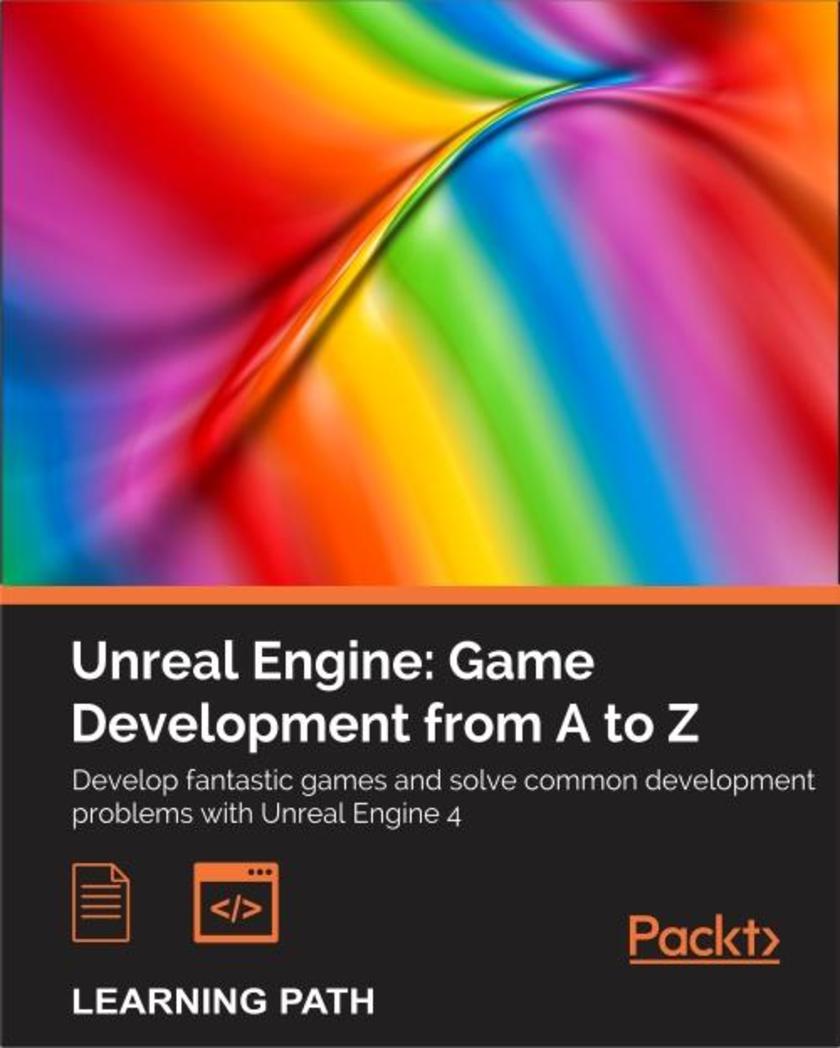
Unreal Engine: Game Development from A to Z
¥179.84
Develop fantastic games and solve common development problems with Unreal Engine 4 About This Book Investigate the big world of Unreal Engine, computer graphics rendering and Material editor to implement in your games Construct a top-notch game by using the assets offered by Unreal Engine, thereby reducing the time to download, create assets on your own. Understand when and why to use different features and functionalities of Unreal Engine 4 to create your own games Learn to use Unreal 4 by making a first person puzzle game, Blockmania, for Android. Who This Book Is For This path is ideal for those who have a strong interest in game development and some development experience. An intermediate understanding of C++ is recommended. What You Will Learn Explore the Unreal Engine 4 editor controls and learn how to use the editor to create a room in a game level Get clued up about working with Slate, Unreal’s UI solution through the UMG Editor Put together your own content and materials to build cutscenes and learn how to light scenes effectively Get tips and tricks on how to create environments using terrain for outdoor areas and a workflow for interiors as well using brushes Explore the ways to package your game for Android Devices and porting it to the Google Playstore Know inside out about creating materials, and applying them to assets for better performance Understand the differences between BSP and static meshes to make objects interactive In Detail Unreal Engine technology powers hundreds of games. This Learning Path will help you create great 2D and 3D games that are distributed across multiple platforms. The first module, Learning Unreal Engine Game Development, starts with small, simple game ideas and playable projects. It starts by showing you the basics in the context of an individual game level. Then, you'll learn how to add details such as actors, animation, effects, and so on to the game. This module aims to equip you with the confidence and skills to design and build your own games using Unreal Engine 4. By the end of this module, you will be able to put into practise your own content. After getting familiar with Unreal Engine’s core concepts, it’s time that you dive into the field of game development. In this second module, Unreal Engine Game Development Cookbook we show you how to solve development problems using Unreal Engine, which you can work through as you build your own unique project. Every recipe provides step-by-step instructions, with explanations of how these features work, and alternative approaches and research materials so you can learn even more. You will start by building out levels for your game, followed by recipes to help you create environments, place meshes, and implement your characters. By the end of this module, you will see how to create a health bar and main menu, and then get your game ready to be deployed and published. The final step is to create your very own game that will keep mobile users hooked. This is what you'll be learning in our third module, Learning Unreal Engine Android Game Development,Once you get the hang of things, you will start developing our game, wherein you will graduate from movement and character control to AI and spawning. Once you've created your application, you will learn how to port and publish your game to the Google Play Store. With this course, you will be inspired to come up with your own great ideas for your future game development projects. Style and approach A practical collection of bestselling Packt titles, this Learning Path aims to help you skill up with Unreal Engine by curating some of our best titles into an essential, sequential collection.




 购物车
购物车 个人中心
个人中心



